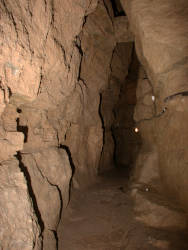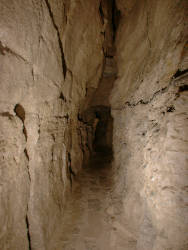Fracture Caves
Rift Cave - Cleft Cave - Crevice Cave - Fault Cave
Fracture Caves are formed by tectonic forces, so they belong to the family of Tectonic Caves. They are the result of divergent movement of sections of the rock.


There are various causes for divergent forces. Within the framework of plate tectonics, whole plates, parts of the crust move away from each other. This creates fissures, which usually reach deep down and are therefore used by the magma of the upper mantle to rise. In the process, the fissure fills and a basalt dyke forms, but unfortunately, no caves.
Another possibility is uplift and subsidence. Since this never occurs evenly, it always results in the fracturing of harder rock layers. In folds with a fold axis, there is the formation of main fissures perpendicular to the strongest expansion movement, secondary fissures in parallel, and further fissures at the two 45° angles to the main fissures. In the case of dome-like bulges, there are correspondingly circular and radial fissures. That there are caves here, however, is also rather rare, as these fissures are usually not wide.
There is a big difference if the extension clefts are above or below the groundwater level. If they are filled with groundwater, they heal up again due to mineralization in the pore water—while they form. In rare cases, ores are deposited, but normally its just calcite or quartz. Even rarer is the formation of crevice caves, when mineralization is slower or the process is somehow stopped. They are usually called crystal caves, crystal grottoes or geodes because of the minerals they contain.
The expansions leading to the formation of caves are usually much smaller and located above the groundwater table. They are mostly due to erosion and the formation of a suitable relief, with steep valley slopes due to the deepening of a valley or the formation of escarpments. The forces are created by gravity and the dead weight of the rock. Especially in the case of sedimentary rocks, with layers with strongly differing properties, a slope edge can then slip, moving on a softer, marly layer. And especially with escarpments, this phenomenon is quite typical, as it is part of the formation process of escarpments.
When a rock package starts to slide, existing fractures that were previously formed by uplift expand. If the process progresses far enough, the fracture can become wide enough to allow a human to enter. Two different processes can be distinguished. First, the rock package tilts towards the mountain and slides down to the valley with its lower end. Then long, straight, high crevices form, tapering towards the top. These are closed, in other words, real caves. If, on the other hand, the rock package is undermined by the erosion of the marl below, and therefore tilts towards the valley at the top, crevices form that become wider towards the top. These are open and are not called caves, but gorges or ravines. In addition, rock debris and plant remains fall in, so they fill up rather quickly. So these fissures are usually filled in to a considerable extent.
In both cases, the fractures are already present in the rock beforehand. If, for example, the rock has already been fractured by uplift or subsidence, these fractures preferentially widen to form crevasses. This often results in a flock of parallel fractures that are either not connected to each other or have a few, smaller transverse fractures.
The terms fissure cave or cleft cave are also often used, but these terms should be used with caution. In karst caves it is often used, simply to describe the morphology, a narrow and high passage. It then refers to a "predominantly fissure-like" cave, which nevertheless originated as a karst cave. Often the fractures were widened by solution or erosion by water from the surface, no movement involved, so sometimes the term fissure cave is used to describe a karst or erosional cave formed by solution along a fissure. The problem is, that the term does not distinguish between different origins, it must be derived from the context. Sometimes, but not always, an adjective is used to make them more specific, like tectonic fissure caves versus solutional fissure caves. The cause of formation is often not easy to identify, and that’s actually the way the term is used in older literature, to describe its form, not its origin. If the origin of the cave is known, it is much better to use more specific terms instead.
For some unknown reason, a bogus description of the term fracture cave was published on the web and even made it on wikipedia. They define them as dissolution of layers of more soluble rocks, the less soluble rock fractures and collapses. While this genesis of caves actually exists, the name is wrong, those are called solutional caves because they are based on chemical dissolving of rocks.
- Examples
 St. Clements Caves, Great Britain
St. Clements Caves, Great Britain Decorah Ice Cave, United States of America
Decorah Ice Cave, United States of America Duncan Escarpment, Canada
Duncan Escarpment, Canada Ellenville Fault Ice Caves, United States of America
Ellenville Fault Ice Caves, United States of America Kristallkluft Gerstenegg, Switzerland
Kristallkluft Gerstenegg, Switzerland Goetz Höhle, Germany
Goetz Höhle, Germany Hoverbergsgrottan, Sweden
Hoverbergsgrottan, Sweden Sandbalmhöhle, Switzerland
Sandbalmhöhle, Switzerland Speco di San Francesco, Italy
Speco di San Francesco, Italy Tianyi Lane, China
Tianyi Lane, China
 Search DuckDuckGo for "Fracture Caves"
Search DuckDuckGo for "Fracture Caves"
 Index
Index Topics
Topics Hierarchical
Hierarchical Countries
Countries Maps
Maps